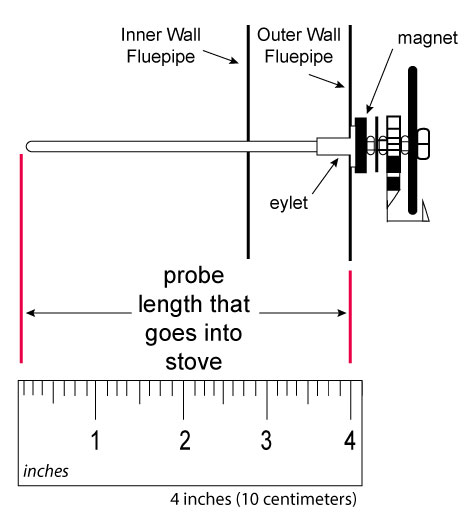Stovepipe probe thermometer instructions

Directions for use
Condar's probe thermometers are designed for insertion into a double-wall stovepipe, with the end of the probe
approximately centered inside the flue for accurate readings.
To install a probe thermometer, drill a 1⁄4 inch hole in the outer wall, and a 3⁄16 inch hole through the inner wall.
Position so the thermometer can be read easily at a glance. Slide the magnet then the eyelet onto the stem of the
thermometer; and insert into the hole.
When properly installed, the stovepipe probe thermometer accurately reads flue-gas temperatures, with an error margin less than 5%. If
placed closer than 18 inches from the top of your stove or furnace, the thermometer will read slightly higher. Creosote
on the stem of the thermometer will have little effect on the readings. When used on horizontal stovepipes, add 6% to
temperature readings due to lower heat transfer. Before cleaning your flue pipe, remember to remove the thermometer.
Guidelines for probe thermometer temperature readings
Consult your stove manufacturer's manual for precise temperature recommendations. See below for approximate guidelines, if probe thermometer is installed properly on the fluepipe. Note that flue-gas readings are approximately 50% higher than surface temperature readings:- 100℉ to 400℉: Temperature too low. Incomplete combustion, causing smoke, soot and hazardous creosote. Open draft and/or add dry fuel.
- 400℉ to 900℉: Safe operating temperature. Complete combustion and best efficiency.
- 900℉ to 1200℉: Wasting energy, possibly overheating. While high temperatures are often reached on initial firing, should not be maintained for normal operation. Reduce draft.
